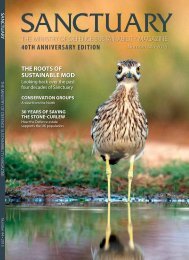SUSTAINABILITY
UBUt5
UBUt5
You also want an ePaper? Increase the reach of your titles
YUMPU automatically turns print PDFs into web optimized ePapers that Google loves.
FEATURES<br />
colonised a new plot on part of the<br />
site that has not held a breeding pair<br />
for over 30 years. Beyond the grass<br />
heath, the MODs tenants also manage<br />
25 stone-curlew plots on arable land<br />
under agri-environment schemes.<br />
Salisbury Plain including Porton Down<br />
in Wiltshire holds the core of the<br />
Wessex stone-curlew population and<br />
is the largest remaining tract of chalk<br />
grassland in North-west Europe, at<br />
around 44,000ha. The grassland on<br />
Salisbury Plain is generally too long for<br />
stone-curlews to nest directly on the<br />
downland, but instead they use the 50<br />
or so plots created and managed by<br />
the MOD. Porton Down still has a large<br />
population of rabbits which keep the<br />
downland cropped very short, and<br />
here, there are still some downland<br />
breeding stone-curlew. Both sites are<br />
designated as Special Protection Areas<br />
for stone-curlew and other protected<br />
species including hobby, quail and<br />
wintering hen harriers.<br />
At all MOD sites it is largely the<br />
lower levels of public access and<br />
disturbance that has maintained<br />
their suitabilit y for stone -curlews.<br />
T herefore, any birdwatchers wishing<br />
to see stone-curlews are direc ted<br />
to the Nor folk Wildlife Trust ’s site at<br />
Weeting Heath in the Breck s, RSPB<br />
Minsmere on the Suf folk Coast,<br />
and RSPB Winterbourne Down<br />
in Wiltshire. All these sites have<br />
dedicated stone -curlew viewing<br />
areas, and arrange popular tours of<br />
autumn roosts.<br />
Volunteers have been instrumental in<br />
delivering stone-curlew conservation<br />
across the UK, with members from<br />
the STANTA and Salisbur y Plain<br />
conservation groups contributing<br />
sightings to the RSPB. Some of the<br />
volunteers play an integral role in<br />
supporting the project.<br />
Colour ringing of chicks has aided<br />
research and stone-curlews have<br />
In 1985, a partnership between<br />
landowners and conservationists began,<br />
which has turned around the fortunes of<br />
these ‘goggle eyed plovers’<br />
become a very well studied species.<br />
PHd research by Ali Johnston has<br />
shown that without the interventions<br />
on cropped land, the population<br />
would once again decline by 4%<br />
per year, but securing more seminatural<br />
grassland habitat could make<br />
stone-curlews sustainable without<br />
intervention. Research has also<br />
revealed that stone-curlews are very<br />
sensitive to all forms of disturbance,<br />
but particularly from dog walkers<br />
within 500m of nest sites. Stonecurlews<br />
are declining elsewhere<br />
in Europe, and climate change<br />
projections show the UK will become<br />
more important for them.<br />
This knowledge gives us the tools<br />
needed to plan for a sustainable UK<br />
population, and military sites remain a<br />
large part of the long term UK strategy<br />
for this species.<br />
Emily Field<br />
RSPB Project Manager for the EU LIFE+<br />
Project ‘Securing the future of the Stonecurlew<br />
in the UK’<br />
Nick Tomalin<br />
Project Manager<br />
RSPB Wessex Stone-curlew<br />
Rob Hawkes<br />
RSPB Heathland Project Offcer for the<br />
Brecks Stone-curlew Project<br />
Stone-curlew chick © RSPB<br />
One of the Wessex plots © RSPB<br />
Sanctuary 44 • 2015<br />
55



